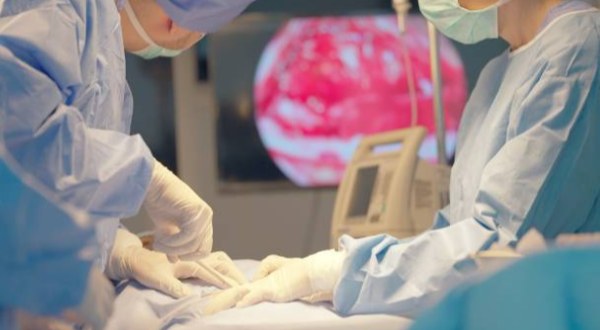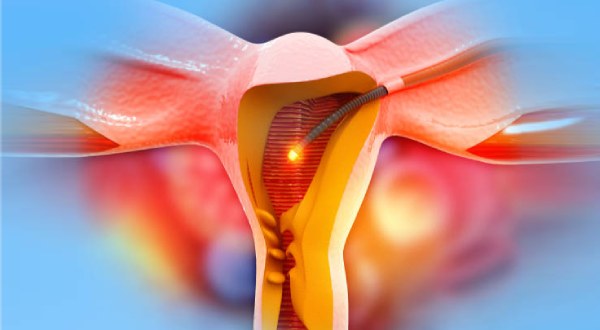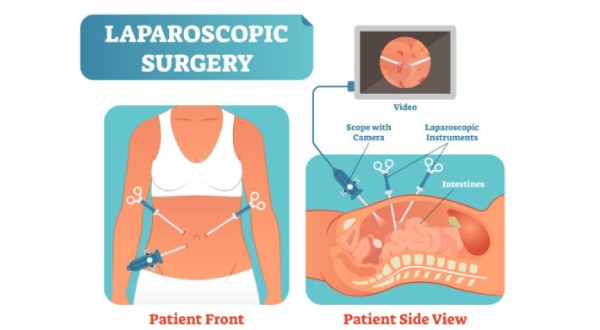Why Choose Laparoscopic Surgery Purpose, Types & Benefits Blogs - AMVI Hospitals

Laparoscopic surgery in Hyderabad, also known as minimally invasive surgery, is a type of surgery that uses a small camera and surgical instruments inserted through small incisions in the abdomen or pelvis. The camera allows the surgeon to see inside the body without having to make a large incision. Laparoscopic surgery is often used to diagnose and treat a variety of conditions, including gallbladder disease, appendicitis, hernias, and gynecological problems.
Purpose of Laparoscopic Surgery
Laparoscopic surgery can be used for a variety of purposes, including:
- Diagnosis: Laparoscopic surgery can be used to diagnose a variety of conditions, including appendicitis, cholecystitis, and endometriosis.
- Treatment: Laparoscopic surgery can be used to treat a variety of conditions, including:
- ➤ Gallbladder disease
- ➤ Appendicitis
- ➤ Hernias
- ➤ Gynecological problems, such as fibroids, cysts, and endometriosis
- ➤ Some types of cancer, such as colon cancer and ovarian cancer
- Biopsy: Laparoscopic procedures can obtain tissue samples for biopsy, which helps in identifying and diagnosing diseases like cancer.
Laparoscopic surgery is also becoming increasingly common for other types of surgery, such as heart surgery and lung surgery.

Types of Laparoscopic Surgery
There are many different types of laparoscopic surgery, but some of the most common include:
- Laparoscopic hysterectomy: Laparoscopic hysterectomy is a surgery to remove the uterus. The uterus is the organ where a baby grows during pregnancy. It may be removed for a variety of reasons, such as cancer, fibroids, or heavy bleeding.
- Laparoscopic myomectomy: Laparoscopic myomectomy is a surgery to remove uterine fibroids. Uterine fibroids are noncancerous growths on the uterus. They can cause pain, heavy bleeding, and other problems.
- Laparoscopic ovarian cystectomy: Laparoscopic ovarian cystectomy is a surgery to remove an ovarian cyst. Ovarian cysts are fluid-filled sacs that can grow on the ovaries. They can cause pain, bloating, and other problems.
- Laparoscopic cholecystectomy: This is a surgery to remove the gallbladder. The gallbladder is a small organ that stores bile, a digestive fluid. It can become inflamed or infected, which can cause pain and other problems.
- Laparoscopic appendectomy: This is a surgery to remove the appendix. The appendix is a small organ that projects from the large intestine. It can become infected, which can cause pain and other problems.
- Laparoscopic hernia repair: This is a surgery to repair a hernia. A hernia is a hole in the muscle wall of the abdomen or pelvis. This can allow organs or tissues to push through the hole, which can cause pain and other problems.
Benefits of Laparoscopic Surgery
Laparoscopic surgery has many benefits over traditional open surgery, including:
- Smaller incisions: Laparoscopic surgery only requires small incisions in the abdomen or pelvis, compared to the large incision required for open surgery.
- Less pain: Laparoscopic surgery is generally less painful than open surgery.
- Less blood loss: Laparoscopic surgery generally results in less blood loss than open surgery.
- Shorter hospital stay: Laparoscopic surgery patients generally have a shorter hospital stay than open surgery patients.
- Faster recovery time: Laparoscopic surgery patients generally have a faster recovery time than open surgery patients.
- Reduced risk of infection: Laparoscopic surgery is associated with a lower risk of infection than open surgery.
Who is a Candidate for Laparoscopic Surgery?
Most people are candidates for laparoscopic surgery. However, there are some people who may not be candidates for laparoscopic surgery, such as people who are very obese or have certain medical conditions.
If you are considering laparoscopic surgery, talk to your doctor to see if it is right for you.
How to Prepare for Laparoscopic Surgery
Before laparoscopic surgery, you will need to prepare for surgery. This may include:
- Getting a physical exam and blood tests: Your doctor will need to make sure that you are healthy enough for surgery and to identify any potential risks. Your doctor will also ask about your medical history and any medications you are taking.
- Stopping smoking: Smoking can increase the risk of complications from surgery, such as infection and blood clots. It is best to stop smoking at least two weeks before surgery.
- Avoiding certain foods and drinks: You may need to avoid certain foods and drinks before surgery to reduce the risk of complications. For example, you may need to avoid caffeine and alcohol, as they can interfere with anesthesia. You may also need to avoid eating solid food for several hours before surgery.
- Taking certain medications: Your doctor may prescribe certain medications for you to take before surgery. For example, you may need to take antibiotics to prevent infection or blood thinners to reduce the risk of blood clots.
- Arranging for transportation: You will not be able to drive yourself for several hours after surgery due to the anesthesia. Make sure to have someone who can drive you home from the hospital.
- Wearing loose-fitting clothing: Wear loose-fitting, comfortable clothing on the day of surgery.
- Removing jewelry: Remove all jewelry, including rings and earrings.
- Taking a shower: Take a shower with antibacterial soap the night before surgery.
- Preparing your home for recovery: Make sure to have plenty of fluids and snacks on hand, and make sure your bed is comfortable.

What to Expect During and After Laparoscopic Surgery?
During Laparoscopic Surgery
- Preparation: Before the surgery, you'll be asked to change into a hospital gown and remove all jewelry or accessories. An IV line may be placed to provide fluids and anesthesia. You'll then be moved to the operating room.
- Anesthesia: Once in the operating room, you'll receive anesthesia, which will make you unconscious during the surgery. In some cases, local anesthesia or regional anesthesia may be used.
- Incisions: Small incisions, usually around 0.5 to 1.5 cm in length, will be made near the surgical area. These incisions are where the laparoscope and specialized surgical instruments will be inserted.
- Carbon Dioxide (CO2) Gas: Carbon dioxide gas is used to inflate the abdominal cavity, creating space for the surgeon to work. This can cause temporary discomfort, including shoulder pain, which is common and usually subsides after the surgery.
- Laparoscopy: A laparoscope, a thin tube with a camera on the end, is inserted through one of the incisions. This camera sends images to a monitor, allowing the surgeon to see inside your body.
- Surgery: The surgeon performs the necessary procedure using small instruments inserted through the other incisions. The laparoscope guides the surgeon throughout the operation.
After Laparoscopic Surgery
- Recovery Room: After the surgery, you'll be taken to a recovery room. You may feel groggy from the anesthesia, but medical staff will monitor your vital signs and ensure you are comfortable.
- Pain Management: You may experience some pain or discomfort in the areas where incisions were made. Your medical team will provide pain relief medication as needed.
- Hospital Stay: In many cases, laparoscopic surgery is performed as an outpatient procedure, meaning you can usually go home on the same day. However, for more complex surgeries or specific medical conditions, an overnight stay may be necessary.
- Activity and Diet: You'll be encouraged to start moving around as soon as you're able, but strenuous activities should be avoided. Your healthcare provider will instruct you on when you can resume a regular diet.
- Incision Care: You'll need to keep your incisions clean and dry to prevent infection. The sutures or staples used to close the incisions will either dissolve or need to be removed during a follow-up appointment.
- Recovery Time: Recovery times vary depending on the specific procedure and your overall health. In general, patients can return to their normal activities more quickly compared to open surgery, but you should follow your doctor's post-operative instructions closely.
- Follow-up Appointments: You will likely have follow-up appointments with your surgeon to monitor your progress and ensure that you are healing properly.
AMVI Hospital is a leading provider of laparoscopic surgery in Hyderabad, offering a wide range of laparoscopic procedures, including hysterectomy, Myomectomy, Tubal Recanalization and more. Our experienced surgeons are highly skilled in the latest laparoscopic techniques, and we are committed to providing our patients with the best possible care.
Conclusion
Laparoscopic surgery is a safe and effective way to treat a variety of conditions. It offers many benefits over traditional open surgery, including smaller incisions, less pain, less blood loss, a shorter hospital stay, and a faster recovery time. If you are considering surgery, talk to your doctor to see if laparoscopic surgery is right for you.
Leave a Reply
Your email address will not be published. Required fields are marked *








